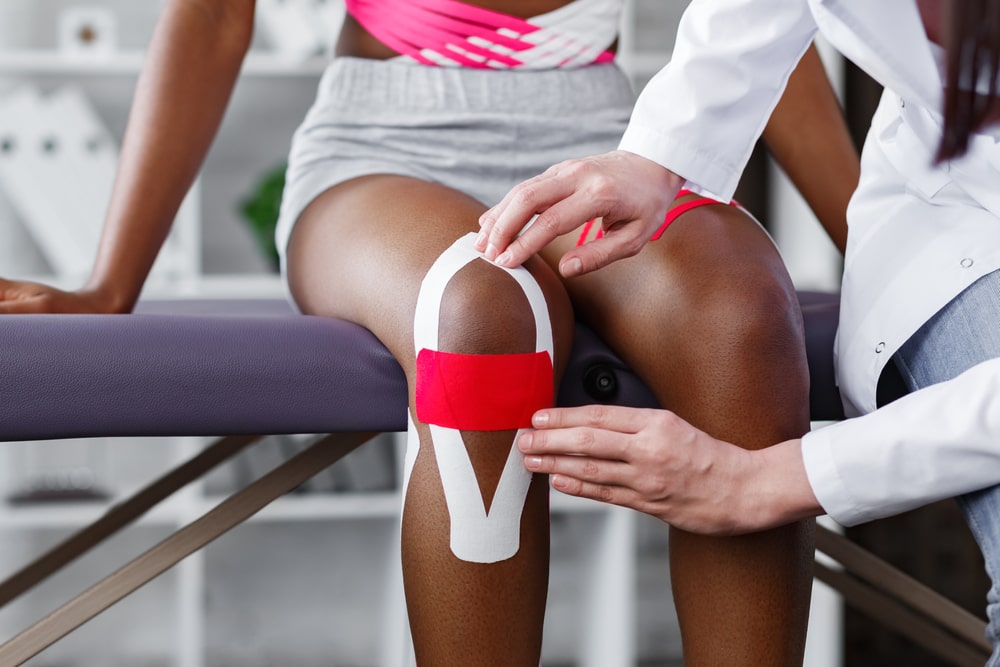Knee taping is a popular method used by athletes, orthopedic doctors, physical therapists, and everyday individuals to provide support, stability, and pain relief for the knee joint. Whether you’re dealing with an injury, managing chronic pain, or looking to prevent discomfort during physical activity, knowing how to tape your knee can help.
In this guide, we explore knee taping, discuss why it’s beneficial, and provide step-by-step instructions on how to tape your knee for stability and pain relief.
What is Knee Taping?
Knee taping is the practice of applying skin-safe adhesive tape to the knee area in specific patterns that support the joint, reduce pain, and prevent injury. Knee-taping techniques can be used in many scenarios, from managing acute injuries like sprains to providing ongoing support for chronic conditions like arthritis. Different types of tape are used for knee taping, including rigid tape for stabilization and elastic kinesiology tape for more flexible support that mimics the natural movement of muscles and joints.
Why Tape a Knee?
Knee taping offers several benefits, making it a versatile tool for both injury prevention and rehabilitation. Here are some common reasons to tape a knee:
- Injury Prevention: Provides extra stability during high-impact activities, reducing the risk of ligament sprains and strains.
- Pain Relief: Eases discomfort from conditions like patellofemoral pain syndrome or osteoarthritis by redistributing pressure and supporting the knee.
- Post-Injury Support: Helps maintain alignment and prevents further damage during recovery, promoting safer healing.
- Improved Performance: Enhances athletic performance by boosting knee stability and confidence during physical activities.
How To Tape a Knee for Pain Relief
The McConnell technique is widely recognized for taping the knee to alleviate pain, particularly for those suffering from patellofemoral pain syndrome (runner’s knee). Developed by Australian physical therapist Jenny McConnell in the 1980s, this technique addresses chronic knee pain by realigning the kneecap (patella) to reduce stress and discomfort. The method uses rigid tape to correct patellar positioning.
Here’s one of many ways to apply rigid tape:
- Gather Your Materials: You need a roll of 2-inch-wide adhesive gauze to protect your skin. You also need a roll of 1 ½ inch-wide rigid athletic tape for support.
- Prepare Your Knee: Sit down with your leg slightly bent and extended in front of you. Cut two pieces of adhesive gauze and place them over your kneecap to prevent skin irritation from the tape.
- Apply the Rigid Tape: Start by placing the middle of a strip of rigid tape directly over the center of your kneecap. Gently pull the tape across the kneecap toward the inner side of your knee while pushing the soft tissue inside your knee toward the kneecap.
- Secure the Tape: Once the tape is correctly positioned, press it firmly against the skin on the inner side of your knee to hold the kneecap in place.
While the McConnel technique is popular, it is one of many. A physical therapist or orthopedic specialist can help you find the best method for your pain.
How To Tape a Knee for Stability
The Kinesio taping technique effectively provides knee stability while maintaining a good range of motion. Unlike rigid taping methods, this technique uses flexible elastic tape that supports the knee without restricting movement, making it ideal for athletes and those needing support during physical activity.
Here’s one of many ways to apply Kinesio tape:
- Gather Your Materials: You’ll need rubbing alcohol, three equal-length strips of athletic tape, and a person to help with the taping.
- Get In Position: Lay down and bend the knee at a comfortable angle.
- Prepare the Knee: Apply rubbing alcohol to clean the knee.
Apply the First Strip: Remove the paper backing from the middle of a strip of tape. Hold onto the ends of the piece of tape. Pull the tape to stretch 50-75%. While the tape is stretched, apply it along the outside of the kneecap. - Apply the Second Strip: Follow the same process to prepare the tape and apply it along the inside of the kneecap.
- Apply the Third Strip: Follow the same process to prepare the tape, but apply it underneath the kneecap, perpendicular to the first and second pieces of tape.
- Activate the Adhesive: After applying each strip, rub the tape gently to make the tape stick securely in place during movement.
To see this method in action, watch the video:
Keep in mind that there are many ways to apply Kinesio tape. Consult with a doctor or physical therapist for the best method for you.
Our Favorite Products
RockTape 2-inch Original
RockTape Black
RockTape Extra Sticky 2 inch
RockTape Tattoo
How To Safely Remove Knee Tape
Removing knee tape correctly is the only way to avoid skin irritation or injury. Follow these steps for safe removal:
- Take Your Time: Slowly peel back the tape, pulling it parallel to the skin rather than away from it. Pulling the tape at this angle helps minimize pain and skin damage.
- Use Oil or Lotion: Applying baby oil, lotion, or warm, soapy water can help loosen the adhesive and make the tape easier to remove.
- Avoid Ripping: Don’t rip the tape off quickly; this can cause skin irritation or remove hair. Instead, gently and slowly pull it off.
- Post-Removal Care: After removing the tape, wash the area with warm water and apply moisturizer to soothe the skin.
Schedule an Orthopedic Consultation with TSAOG
If you’re experiencing persistent knee pain or instability, it’s important to consult with a healthcare professional for a comprehensive evaluation. While taping may be a part of your care plan, you may need additional treatments to feel your best again. At TSAOG Orthopaedics & Spine, our experienced team of specialists can assess your condition and recommend the most effective treatment plan.
If you’re wondering when to see a doctor for knee pain, check out our blog on the topic.
Schedule an appointment today for expert care and take the first step towards a pain-free, stable knee.














